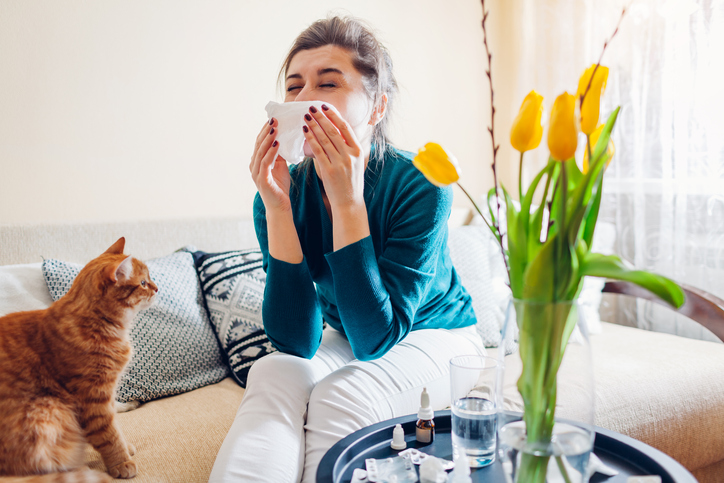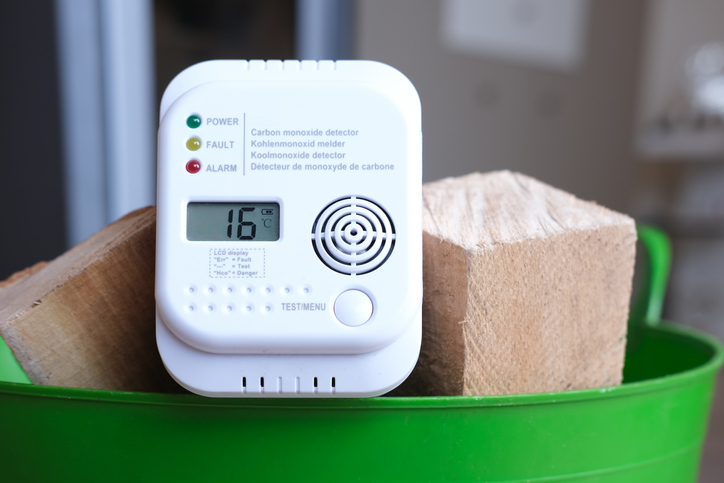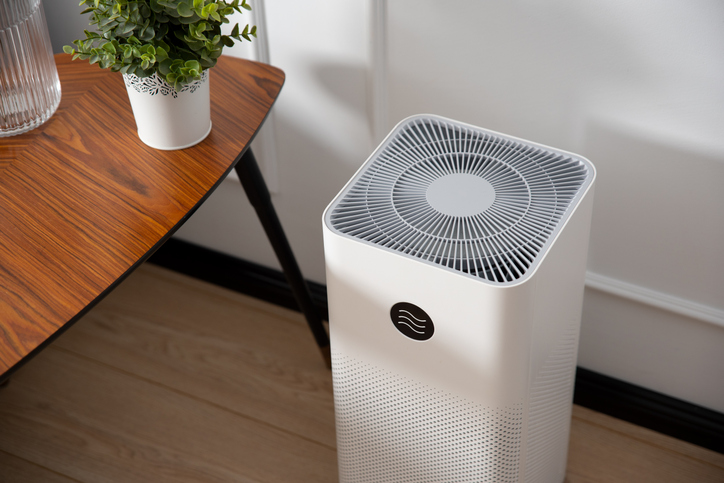Creating a safe and conducive home environment is a cornerstone of well-being, particularly for individuals grappling with allergies. The intricate interplay between indoor and outdoor factors can significantly impact respiratory health and overall comfort. From the meticulous management of indoor air quality to astute landscaping practices and mold prevention, this guide equips individuals with the knowledge and tools to curate a home that champions respiratory wellness and enhances the quality of life for allergy-sensitive occupants.

Creating An Allergen-Free Sleeping Environment
The bedroom is a sanctuary for rest and rejuvenation, making it an essential focal point for allergy management. For those who suffer from allergies, the bedroom can either be a haven of relief or a source of exacerbated symptoms. Allergens like dust mites, pet dander, pollen, and mold have a tendency to accumulate within this space, potentially leading to discomfort and disrupted sleep patterns. By emphasizing allergen reduction strategies in the bedroom, individuals with allergies can experience a noticeable improvement in sleep quality and overall well-being.
To effectively manage allergies in the bedroom, several strategies can be employed. Regular cleaning and diligent dusting routines can help minimize the accumulation of allergens. During high pollen seasons, keeping windows closed can prevent outdoor allergens from infiltrating the room. Opting for allergen-proof mattresses and pillow covers can create a protective barrier against dust mites and other potential irritants. Additionally, selecting window treatments that are easy to wash and maintain can help prevent the trapping of allergens.
Selecting Hypoallergenic Bedding And Pillows
When it comes to creating an environment conducive to alleviating allergies, the choice of bedding and pillows becomes a critical consideration. Opting for hypoallergenic materials can significantly diminish the risk of exposure to allergens that might trigger unpleasant reactions. When selecting bedding and pillows, a few key factors come into play. The choice of materials matters greatly; materials such as microfiber, cotton, or bamboo tend to be less prone to harboring allergens.
Equally important is the type of fill used in pillows; pillows with synthetic fills are often preferable, as natural materials like feathers can potentially host dust mites. Ease of cleaning is also a crucial consideration; bedding that can be easily machine-washed at high temperatures helps ensure allergens are effectively eliminated. Seeking out certifications or labels indicating “allergen-proof” or endorsements from reputable organizations like the Asthma and Allergy Foundation of America (AAFA) can guide selections.
Maintaining Optimal Humidity Levels
The role of humidity within the bedroom holds significant sway over allergy management. Striking the right balance in humidity levels is crucial for preventing the proliferation of mold and dust mites, both of which can aggravate allergies and respiratory issues. Whether the air is excessively dry or overly humid, it can potentially trigger discomfort and health concerns.
To ensure an environment that is conducive to allergy relief, several tips for humidity control can be employed. Introducing a dehumidifier proves especially effective in regions with high humidity, as it helps maintain an optimal level of moisture, inhibiting the growth of mold. Consistently monitoring humidity levels within the range of 30-50% using a hygrometer is recommended. Adequate ventilation, achieved by keeping windows open when feasible, also aids in preventing excessive humidity accumulation.
Regular cleaning and vacuuming of the bedroom play a pivotal role in preventing the buildup of dust mites and mold spores, which can thrive in overly humid conditions. By vigilantly managing humidity levels, individuals can cultivate a bedroom environment that discourages allergen growth, fostering improved sleep quality and overall well-being.
Improving Indoor Air Quality
Effective ventilation stands as a cornerstone of allergy control within indoor spaces. The significance of proper ventilation extends beyond mere comfort, as it directly impacts indoor air quality and the well-being of individuals with allergies. Insufficient ventilation can lead to the accumulation of allergens and pollutants, such as dust mites, pet dander, and volatile organic compounds (VOCs), exacerbating allergy symptoms and potentially contributing to respiratory issues. By facilitating the movement of air, adequate ventilation helps disperse and dilute allergens, creating a healthier living environment.
Regularly opening windows during periods of low outdoor allergen levels allows fresh air to circulate and replace indoor pollutants. The utilization of exhaust fans, especially in moisture-prone areas like kitchens and bathrooms, aids in expelling allergen-rich air from indoors.
Employing mechanical ventilation systems, such as energy recovery ventilators (ERVs) and heat recovery ventilators (HRVs), ensures a continuous exchange of indoor and outdoor air, effectively managing allergen concentrations. Scheduled maintenance of heating, ventilation, and air conditioning (HVAC) systems guarantees efficient airflow and filtration, preventing the accumulation of allergens.
Effectiveness Of Air Purifiers In Allergen Reduction
Air purifiers, renowned as stalwarts of air filtration, furnish a compelling solution for diminishing indoor allergens and elevating air quality. These innovative devices function by actively drawing ambient air into their systems and methodically directing it through purpose-built filters engineered to apprehend an array of airborne particles, including allergens and contaminants. Of particular relevance to individuals contending with allergies, air purifiers furnish an auxiliary avenue for managing allergen exposure, proving especially valuable when conventional ventilation may be constrained or when outdoor allergen concentrations are notable.
Fortified with high-efficiency particulate air (HEPA) filters, a hallmark of premium air purifiers, these mechanisms proficiently ensnare particles as minuscule as 0.3 microns. This encompassing capacity encompasses an array of allergens, spanning from dust and pollen to pet dander and even diminutive mold spores.
Empirical data points to a correlation between the use of air purifiers and the amelioration of allergy symptoms. These devices exhibit the potential to curtail sneezing, coughing, nasal congestion, and related discomforts, ultimately contributing to an elevated quality of life.
Prudent selection of an appropriately proportioned air purifier, coupled with strategic placement proximate to potential allergen sources, optimizes the efficacy of the apparatus. Routine replacement of filters emerges as a pivotal facet of sustaining optimal air purifier performance. Certain models integrate reusable or washable filters, augmenting user convenience.
According to the American Academy of Allergy, Asthma & Immunology, indoor allergens like dust mites, pet dander, mold, and pollen can often trigger or worsen allergy symptoms, affecting an estimated 50 million people in the United States alone.
Managing Dust Mites And Pet Dander
Dust mites and pet dander are two prevalent allergens that can significantly impact the indoor air quality and overall comfort of individuals prone to allergies. Dust mites are microscopic arachnids that thrive in warm, humid environments, feeding on skin flakes shed by humans and pets. Their waste particles, rather than the mites themselves, are the primary culprits behind allergic reactions. Pet dander, on the other hand, consists of tiny skin cells, saliva, and urine shed by animals like cats, dogs, and rodents. These allergens can become airborne and settle on surfaces, leading to allergic symptoms when inhaled or upon skin contact.
Strategies For Minimizing Dust Mites
Minimizing the presence of dust mites requires a comprehensive and strategic approach that involves a variety of practices aimed at reducing their population and impact on indoor air quality.
A fundamental aspect of managing dust mites involves adopting a consistent and thorough cleaning routine. Regular vacuuming using a vacuum cleaner equipped with a high-efficiency particulate air (HEPA) filter proves effective in extracting dust mites and their residual particles from carpets, rugs, and upholstered furniture. This diligent cleaning helps create an environment less conducive to triggering allergic reactions.
In the bedroom, where dust mites can be particularly problematic, implementing specific strategies is crucial. Encasing mattresses, pillows, and box springs with allergen-proof covers establishes a barrier against dust mites. Opting for bedding materials that are easily washable and avoiding heavy fabrics that can accumulate dust further contributes to reducing allergen levels in the sleeping area.
Humidity control plays a significant role in deterring dust mite proliferation. Maintaining indoor humidity levels within the recommended range of 30-50% helps create an unfavorable environment for their growth. Dehumidifiers can be especially beneficial in areas where dampness is a concern.
Minimizing clutter and reducing the presence of items that can trap dust, such as stuffed animals and excess decorations, is essential. This decluttering process eliminates potential hiding spots for dust mites, thereby creating a less hospitable habitat for them.
Consideration of flooring choices also comes into play. Transitioning from wall-to-wall carpets to hard flooring options like hardwood, tile, or vinyl reduces the potential for dust mite accumulation. These types of flooring materials are inherently less likely to harbor allergens, contributing to a cleaner living environment. Managing indoor temperatures can have an impact on dust mite populations. Cooler temperatures can deter their reproductive cycle, leading to fewer dust mites in the living space.
Minimizing Pet Dander Exposure
Effectively managing exposure to pet dander necessitates a combination of prudent pet care practices and targeted adjustments within the living environment. These strategies are particularly crucial for individuals who are sensitive to pet allergens and seek to create a more comfortable living space.
Regular pet grooming and bathing are foundational steps in reducing the amount of dander shed by animals. Frequent grooming helps mitigate the release of allergenic particles into the air, thereby diminishing the potential for allergic reactions.
Creating designated pet-free zones within the home serves as a strategic measure to minimize allergen spread. Establishing specific areas where pets are not allowed, such as bedrooms and certain items of furniture, can significantly curtail the presence of pet dander in these crucial spaces.
Consistent cleaning practices are paramount in managing pet dander. Frequent vacuuming using a vacuum cleaner equipped with a high-efficiency particulate air (HEPA) filter proves effective in capturing and removing airborne pet allergens. A damp dusting of surfaces further helps trap and eliminate dander particles.
For additional air quality improvement, consider incorporating HEPA air purifiers in rooms where pets spend a significant amount of time. These devices can effectively capture and filter out airborne pet allergens, contributing to a cleaner and more allergy-friendly indoor environment.
Opting for washable covers for furniture and bedding that pets come into contact with allows for easy removal and cleaning of accumulated dander. This practice further reduces the potential for allergen buildup and helps maintain a healthier living space.
Exploring allergen-reducing pet products, such as specially formulated shampoos and wipes, can also be advantageous. These products are designed to mitigate the release of allergenic particles from pets, providing an additional layer of defense against pet dander exposure.
Flooring And Furniture Choices
The choices made in flooring and furniture materials have a profound impact on the presence of allergens within indoor spaces. Both flooring and furniture can contribute significantly to the accumulation and retention of allergenic particles, affecting the overall air quality and comfort for individuals with allergies.
Flooring materials, whether carpet, hardwood, laminate, or tile, can either harbor or deter allergens. Carpeting, for example, can trap dust, pet dander, and other particles deep within its fibers, making it a potential reservoir for allergens. Hard flooring surfaces, on the other hand, are generally easier to clean and less likely to retain allergens.
Furniture materials also play a role in allergen accumulation. Upholstered furniture, such as sofas and chairs, can trap dust mites, pet dander, and other allergenic particles in their fabric and padding. Smooth, non-porous furniture surfaces are less likely to harbor allergens and can be more effectively cleaned.
Allergen-Resistant Flooring Options
In the quest for an allergy-conscious living environment, the choice of flooring materials becomes a pivotal factor. Delving into allergen-resistant flooring options presents an opportunity to proactively reduce the presence of allergens and create a more healthful indoor atmosphere.
Hardwood emerges as a formidable contender in the realm of allergen resistance. When appropriately sealed, hardwood floors provide a smooth and impermeable surface that discourages the accumulation of dust mites, pet dander, and other allergenic particles. Regular maintenance routines such as sweeping and damp mopping prove efficacious in whisking away potential irritants from these surfaces.
The allure of laminate flooring lies in its durability and ease of maintenance. Engineered with a sealed surface, laminate flooring acts as a barrier against allergens, making it an appealing option for those seeking to mitigate allergen presence.
Both tile and vinyl flooring boast non-porous properties, rendering them inhospitable to allergen retention. Their smooth and wipeable surfaces enable effortless removal of dust and particles, contributing to a cleaner and more allergy-friendly space.
Embracing the elegance of natural stone, such as marble or granite, extends beyond aesthetics. These surfaces exhibit inherent resistance to allergen buildup, harmonizing aesthetic appeal with practicality.
Selecting Furniture Materials To Reduce Allergens
The influence of furniture materials on allergen accumulation underscores the importance of astute choices when furnishing indoor spaces. A deliberate selection of furniture materials can significantly impact allergen retention and contribute to a more allergy-friendly living environment.
Opting for furniture upholstered in leather or vinyl presents a practical solution for minimizing allergen buildup. Unlike fabric-covered furniture, leather or vinyl surfaces are less likely to trap and retain allergenic particles. These materials offer the advantage of easy cleaning, as they can be wiped down to effectively remove potential irritants.
Furniture featuring smooth, non-porous surfaces is inherently less susceptible to allergen accumulation. Materials like wood, metal, or plastic are less likely to harbor dust mites or pet dander, making them ideal choices for those seeking to curtail allergen presence.
For fabric-covered furniture enthusiasts, the consideration of washable covers is pivotal. Opting for furniture with removable, washable covers facilitates regular cleaning, which can substantially reduce allergen levels and enhance indoor air quality.
Some furniture manufacturers offer anti-allergen treatments as an additional layer of defense. These treatments are designed to mitigate the adherence of allergens to furniture materials, providing an extra measure of allergen reduction.
Natural Remedies And Effective Cleaning Practices
In the pursuit of alleviating allergy symptoms and promoting overall well-being, the integration of natural remedies can offer a holistic and complementary approach. While it’s important to note that natural remedies should not replace prescribed medical treatments, they can serve as supportive measures in managing allergies.
Employing a saline solution for nasal rinsing proves beneficial in clearing nasal passages, reducing congestion, and providing relief from sinus discomfort associated with allergies.
Inhaling steam infused with essential oils like eucalyptus or peppermint can prove soothing and effective in easing congestion and calming irritated airways, contributing to enhanced respiratory comfort.
The consumption of locally sourced honey is believed to introduce trace amounts of local pollen into the body, potentially aiding in the gradual reduction of allergy symptoms over time. The inclusion of quercetin-rich foods such as apples, onions, and berries in one’s diet may offer anti-inflammatory properties, potentially assisting in mitigating allergic reactions.
Probiotics, known for their potential to modulate the immune response, have been explored for their role in reducing allergy symptoms and promoting a balanced immune system. Extracts from the butterbur plant have been investigated for their potential to alleviate allergy symptoms, particularly those associated with hay fever, offering a plant-based avenue for relief.
Alternative, Allergy-Friendly Cleaning Products
In the realm of household cleaning, the exploration of alternative products that are friendly to allergy sensitivities can significantly contribute to a healthier and more comfortable living environment. Conventional cleaning products often contain chemicals that may trigger or exacerbate allergy symptoms. Delving into alternative options allows for a shift towards gentler and less allergenic cleaning practices.
Embracing the power of natural ingredients, substances like vinegar and water, lemon juice, or baking soda can serve as effective alternatives to commercial cleaners laden with potentially irritant chemicals. These natural solutions possess cleaning properties while being kinder to both indoor air quality and respiratory health.
The inclusion of high-efficiency particulate air (HEPA) filters within vacuum cleaners is instrumental in capturing minuscule particles, preventing allergens like dust, pollen, and pet dander from being redistributed back into the air during the cleaning process. This technology enhances the efficacy of cleaning routines while minimizing the potential for allergen dispersal.
Essential oils, renowned for their antimicrobial properties and pleasing aromas, can be harnessed to enhance cleaning practices. Oils such as tea tree, lavender, and eucalyptus can be integrated into homemade cleaning solutions, offering a dual benefit of cleanliness and a naturally refreshing atmosphere.
When tending to laundry, opting for hypoallergenic laundry detergents proves advantageous. These specialized detergents are formulated to reduce the presence of allergens on clothing and bedding, contributing to an environment that is less likely to trigger allergic reactions.
Outdoor Allergen Prevention
Shielding indoor environments from the infiltration of outdoor allergens requires a multifaceted approach that fortifies the boundaries between the exterior and interior. By implementing effective strategies, individuals can minimize the influx of pollen, dust, and other outdoor irritants into their living spaces.
To mitigate outdoor allergen entry, limit the periods of open-window ventilation during peak pollen seasons. Opt for early mornings or late evenings when pollen counts are lower. Place coarse-textured doormats at entryways to trap outdoor allergens on shoes before they enter the home. Encourage a no-shoes policy indoors to prevent allergens from being tracked indoors.
Consider creating an “airlock” entryway by having an additional door or vestibule that serves as a buffer zone, allowing individuals to remove outerwear and shoes before entering the main living area. Regularly inspect and seal any gaps, cracks, or openings in windows, doors, and walls to prevent allergens from infiltrating through these avenues.
Groom and clean pets before they enter the house to minimize the transfer of outdoor allergens they may carry on their fur.
Landscaping Practices For Reduced Allergen Exposure
Mindful landscaping practices wield a substantial influence over the degree of outdoor allergen exposure experienced in the vicinity of one’s home. By conscientiously shaping the outdoor environment, individuals can take proactive steps to minimize the presence of allergenic agents and create a more allergy-resilient outdoor space.
The deliberate choice of plants plays a pivotal role. Opting for plants that are inherently low in allergenic potential or possess natural resistance to allergen dissemination is paramount. These selections release minimal pollen, reducing the likelihood of triggering allergic reactions.
Regular and attentive yard maintenance assumes significance in allergen control. Consistent practices such as lawn mowing, shrub trimming, and weed removal curtail the proliferation of allergenic plants, thus mitigating the release of pollen into the surrounding air.
The strategic positioning of trees within the landscape proves integral. Placing trees away from windows and outdoor seating areas minimizes the chances of pollen being carried indoors by the wind, contributing to a more allergen-sparing outdoor atmosphere.
The selection of ground covers, such as mulch or gravel, in specific areas merits consideration. Opting for alternatives to grass can lessen pollen production and establish a protective barrier against allergen dispersal, reinforcing the efforts to cultivate an outdoor space that is less prone to triggering allergies.
Mold Prevention And Home Maintenance
Awareness of the potential allergy-related hazards posed by mold is vital in the quest for a healthier and more allergy-resilient living space. Mold, a type of fungi thriving in moist and humid conditions, can trigger allergic reactions, particularly in those susceptible to mold allergens. By identifying the signs of mold-related allergies, individuals can take informed steps to mitigate its impact and create an environment that promotes respiratory well-being.
Exposure to mold spores released into the air can lead to a range of respiratory symptoms, including persistent coughing, uncontrollable sneezing, wheezing, and a sensation of breathlessness—especially pronounced among individuals with heightened mold sensitivities.
Mold exposure can contribute to nasal congestion, often accompanied by a runny nose and sinus discomfort, closely mirroring symptoms of a common cold. Direct contact with mold or mold-contaminated surfaces can also result in skin irritation or rash, making it crucial to recognize these dermatological indicators. In addition, mold allergens can instigate ocular distress, leading to redness, itchiness, and excessive tearing of the eyes—an aggravating factor for existing eye allergies. For individuals grappling with asthma, mold exposure presents the heightened risk of exacerbating asthma symptoms, ushering in bouts of coughing, wheezing, and impaired breathing.
Importance Of Regular HVAC Maintenance
Undoubtedly, the integrity of a home’s heating, ventilation, and air conditioning (HVAC) system is of paramount importance when it comes to maintaining optimal indoor air quality and mitigating allergen risks. Regular and meticulous HVAC maintenance serves as a cornerstone in upholding a living environment that is both conducive to respiratory health and resilient against allergen infiltration.
Central to this maintenance regimen is the meticulous selection and upkeep of air filters, particularly those of the high-efficiency particulate air (HEPA) variety. These specialized filters exhibit a remarkable ability to ensnare minuscule particles, including mold spores, pollen, and dust—thereby circumventing their circulation within indoor air. Moreover, periodic professional cleaning of HVAC ducts emerges as an essential practice to thwart the accumulation and dispersal of allergens, ensuring that the system functions as a conduit for clean and purified air.
Safeguarding indoor humidity levels is another pivotal facet of HVAC maintenance. Effective regulation of humidity within the recommended range of 30-50% serves as a potent deterrent against mold proliferation, as mold thrives in damp environments. Timely repairs of any system malfunctions, such as leaks or condensation issues, are equally crucial, as they prevent the creation of conducive conditions for mold growth and contribute to a more stable indoor environment. Ultimately, a well-maintained HVAC system stands as a stalwart guardian, actively fostering an indoor milieu that champions respiratory wellness and allergy management.
Strategies For Mold Prevention And Upkeep
Nurturing an environment inhospitable to mold growth necessitates a proactive and multifaceted approach that encompasses various preventive strategies and vigilant upkeep measures.
Effective ventilation emerges as a foundational element in mold prevention. Ensuring proper airflow, particularly in moisture-prone spaces like bathrooms and kitchens, serves as a deterrent against excessive humidity and consequent mold development. Regular cleaning and thorough drying of areas susceptible to moisture accumulation—such as shower stalls, sinks, and windowsills—are essential practices that disrupt the conditions conducive to mold growth.
Vigilance in promptly addressing any leaks, whether stemming from pipes, roofs, or windows, is paramount. Swift remediation of such issues mitigates the potential for dampness, a catalyst for mold proliferation. Proper insulation of walls, windows, and roofs contributes to a controlled indoor environment by minimizing the occurrence of condensation, a precursor to moisture buildup.
Conclusion
In the quest for a home that prioritizes the well-being of individuals with allergies, a comprehensive approach to minimizing allergens and irritants emerges as paramount. By weaving together prudent choices in home design, indoor air quality management, cleaning practices, outdoor allergen prevention, and mold prevention, individuals can establish a sanctuary that fosters respiratory health, comfort, and overall quality of life. Through a harmonious synergy of knowledge, vigilance, and proactive measures, the journey towards a safer and more allergy-conscious living environment is both achievable and deeply rewarding.




